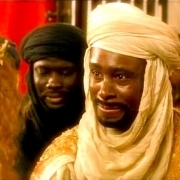
[Serv.] There is a forerunner come from a fift, the Prince of Morocco, who brings word the Prince his master will be here to-night.
Por. If I could bid the fift welcome with so good heart as I bid the other four farewell, I should be glad of his approach. If he have the condition of a saint and the complexion of a devil, I had rather he should shrive me than wive me.
The Merchant of Venice, 1.2.124-31
Critics have considered the Prince of Morocco’s black skin in the context of other Moors on the Renaissance stage, and in the context of its performance history, but not very seriously as an integral part of the structure and themes of The Merchant of Venice, a play bristling with stigma. At least one editor has speculated that the actor playing Shylock could have doubled as the Prince of Morocco, a dramaturgical provocation we need not actually accept in order to explore the parallel plights of these two stigmatics, the one a Jew and the other a Moor. For, interpolated across the first two acts of The Merchant of Venice, Portia’s stigmatization of Morocco frames and thereby comments upon the Venetians’ stigmatizations of Shylock, each instance affected in the language of “darkness” and “devils.” Portia maligns Morocco’s black skin in I.ii. before he actually appears on stage for himself in II.i., the object preempted by the interpretation, fact by meaning, as always occurs with stigma. Whether obtuse or malicious, Portia speaks as though the meaning of stigma comes from the aberrant body itself, not from her interpretation of that body. In the conceptual slide that underwrites all stigma, her interpretation divides both ethics (“condition[s]”) and aesthetics (“complexion[s]”) into polarized categories of “the good” (saintly conditions, white complexions) and “the bad” (devilish conditions, black complexions), and then she acts as though one good signifies another (as though whiteness signifies saintliness), and one bad another (as though blackness signifies the demonic). In terms of the dramatic structure and timing of Merchant, this prejudiced pronouncement of the coming of Morocco, who does not actually appear for some time, is really a flourish of sorts for Shylock’s first entrance in the scene that comes between the announcement and the appearance of Morocco. In this scene, Shylock rails against the anti-Semitism in Venice until the scene shifts back to Belmont, where Morocco’s very first words are a defense of his skin color. Both Morocco and Shylock are on their asses to defend their identities from their very first appearances, and their subsequent actions show some of the effects of being stigmatized.
In the first casket scene, Morocco chooses the gold casket on the basis of the very aesthetic Portia applied to him earlier, the aesthetic of similitude: the gold casket must contain the picture of Portia, he reasons, because the things we deem good, beauty and virtue, must go together. Having repeatedly been subjected to this aesthetic of kalokagathia, “the beautiful and the good,” for his entire life, Morocco has internalized the idea that external appearances signify internal qualities. In a similar vein, the remainder of The Merchant of Venice shows Shylock increasingly comporting his character to the caricature of a villainous Jew that the Venetians have saddled on him since before the play even began. Now, Morocco’s gold casket actually contains a skull and a grade-school lesson not to assume that things are as they appear on the outside: “Gilded tombs do worms enfold.” After this admonition, Portia’s overt racism (“Let all of his complexion choose me so,” she says as Morocco exits) casts a particularly bad light on her, the same bad light that shines on Salanio and Salarino in a later scene when they echo Portia’s treatment of Morocco while stigmatizing Shylock as demonic and dark, seeing him and saying, “The devil … comes in the likeness of a Jew,” hearing him lament his lost daughter and laughing, “There is more difference between thy flesh and hers than between jet and ivory.”
Context
Black Skin on the Elizabethan Stage
Black Skin in Early English Literature
Black Skin in Shakespeare
Bibliography
Floyd-Wilson, Mary. “The Ghost of Hippocrates: Geohumoral History in the West.” English Ethnicity and Race in Early Modern Drama. Cambridge: Cambridge University Press, 2003. 23-47.
Ungerer, Gustav. “Portia and the Prince of Morocco.” Shakespeare Studies 31 (2003): 89-126.
Vaughan, Virginia Mason. “Representing the King of Morocco.” Emissaries in Early Modern Literature and Culture: Mediation, Transmission, Traffic, 1550-1700. Ed. Brenda Charry and Gitanjali Shahani. Aldershot: Ashgate, 2009. 77-92.
Sokolova, Boika. “Reading Morocco: Four Film Versions of The Merchant of Venice.” Shakespeare Closely Read; A Collection of Essays: Written and Performance Texts. Madison, NJ: Fairleigh Dickinson University Press, 2011. 93-115.
Drakakis, John. "Shylock, Morocco, Othello: On Representing the Shakespearean Intertext." The Construction of the Other in Early Modern Britain: Attraction, Rejection, Symbiosis. Ed. Rüdiger Ahrens. Heidelberg: Winter, 2013. 109-22.
Smith, Ian. "The Textile Black Body: Race and 'Shadowed livery' in The Merchant of Venice." The Oxford Handbook of Shakespeare and Embodiment: Gender, Sexuality, and Race. Ed. Valerie Traub. Oxford: Oxford University Press, 2016. 170-85.
Akhimie, Patricia. Introduction to Shakespeare and the Cultivation of Difference: Race and Conduct in the Early Modern World. New York: Routledge, 2018. 1-48.
Varnado, Christine. "The Quality of Whiteness: The Thief of Bagdad and The Merchant of Venice." Exemplaria 31.4 (2020): 245-69.